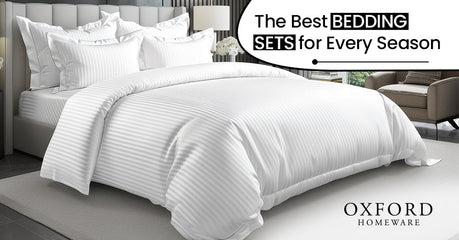Why Do You Have So Many Gaps In Your Fitted Sheet
In widespread use are fitted sheets, which are made to fit tightly over a mattress and have elasticised borders to keep them in place. Many individuals, however, have experienced the discomfort and frustration of finding holes or creases in their fitted sheets.
It is frustrating; you're enjoying some much-needed sleep as you're fast asleep. The sheets on the bed suddenly snap off as you adjust your sleeping positions, rousing you from your slumber. Don't worry if you need help with how to maintain bed linens. We know numerous ways to help you maintain your sheet in place so you can have a restful night's sleep.
So, why do standard 40 cm fitted sheets have so many gaps? The mattress's dimensions, the sheet's fabric, and the method by which it is placed into the bed are just a few factors that might cause this. This article will investigate these factors and advise on improving your fitted sheet's snugness.
What Are Fitted Sheets?
Unlike a flat sheet, which is just a rectangular piece of fabric, a fitted sheet has an elastic band around the perimeter. When placed on the corners of your mattress, these elasticised corners will hold it securely in place. Whether you want to sleep directly on the mattress or use a mattress cover, you may put your fitted sheet directly on top.
You may need additional fitted sheets if the mattress is exceptionally thick or if you're using a mattress topper. Thanks to the deep pocket, your sheets won't bunch up at the corners of your mattress, making it easier to cover the whole bed with sheets. Oxford homeware have multiple colours in 40cm fitted sheets including white, grey, charcoal, navy, red, black, light blue, pink, ochre, cream and purple.
How Does The Gap Of Fitted Sheets Affect Your Comfort?
How well your fitted sheets fit significantly influences several facets of bedtime and rest.
Trouble Falling Asleep And Waking Up In Pain
Having a properly fitting sheet may be quite annoying and uncomfortable. If your fitted sheet is too tiny or shallow, it may slide off your mattress in the middle of the night, waking you up. This might prevent you from getting enough shut-eye, making you feel dizzy and tired the following day.
It's Easier To Get Reactions And Skin Problems
Allergies and skin irritations are two more conditions made worse by a sheet that doesn't fit properly. Your skin might become irritated or even break out in rashes if the sheet is excessively tight and pressed against it. Allergies and respiratory issues may be triggered by dust and other allergens that can be trapped between a loosely fitted sheet and a mattress.
Beds And Fitted Sheets Wear Out Faster
Lastly, how well the fitted sheet fits might affect the sheet's and the mattress's longevity. If the fitted sheet is overly tight, the mattress will wear out faster since the corners will be pulled. A mattress that shifts about too much because of a too-loose sheet may lose its original contour.
9 Major Reasons For Fitted Sheet Gaps
Improperly Assembling A Fitted Sheet
The fact that your fitted sheet won't stay in place is probably because you need to put it on correctly. Please look at the back of your sheet with the elastic on it. A tag will be stitched onto the inner edge of one of the four-sided pockets when it is being constructed. The tag's pocket should be placed over the mattress's lower left corner to ensure a secure, slip-free fit. Left is based on how you would see things lying in bed.

The Sheets Seemed To Have An Improper Pocket Depth
Fitted sheets now come in various pocket depths to match the wide range of mattress thicknesses available today. Because the pockets are either too deep or too shallow for your mattress, a fitted sheet will only hold the sheet taut if it has the appropriate pocket depth for your bed. The answer is to measure your bed to determine the correct fitted sheet size and purchase a genuinely fitting sheet. If you are looking for 25 cm fitted sheets then these colours are avaialble on oxford homeware white, grey, charcoal, navy, red, black, light blue, pink, ochre, cream and purple.
The Measurements Of The Sheet
The king-sized deep-fitted sheets perfectly fit the size and thickness of your mattress from top to bottom. Knowing your mattress' precise depth is crucial when looking for new fitted sheets. Based on that information, you must only purchase deep-fitted sheets. The most frequent problem with extra deep double-fitted sheets is an abnormally tight fit or insufficient sheet depth.

Also Read: Stylish Bedspreads - A luxury Addition To Your Bed
Overly Squeezing The Fit Of The Bedding
It can be difficult to sleep if your bedding is tucked in so snugly that your feet squish together when you're covered. They developed a unique snap method to attach the fitted sheet to a duvet cover. As a result, the bedding can be tucked in. This innovative design prevents delicate toes from being crushed and coverings from falling off or wrapping around the mattress.

Purchasing Inferior Sheets
Your ability to sleep well might be enhanced or ruined by your bed sheets. Cotton linens are more stain-resistant than synthetic ones, allowing your skin to breathe. With time, they also become softer. The softest sheets typically have a sateen finish.

Also check: A Guide To Buying Quality Bed Linen
It's The Thread That Matters, Not The Count
In this case, quantity (thread count) does not indicate quality (cotton). The sort of cotton being used is a more reliable predictor. Pima, lengthy Egyptian, and Supima are the finest options.
Temperature Is Crucial
Cotton sheets are naturally moisture-wicking, so they will keep you cooler whether you sleep on a foam mattress that absorbs heat or if you tend to sweat heavily during the night. Try using sheets made of cotton combined with linen, an environmentally friendly material with a reputation for absorbing moisture, if your cotton sheets aren't keeping you dry.
Standard Measures
The manufacturer of fitted sheets defines the size and the maximum mattress depth it can accommodate. Before making a purchase, ensure that you measure the mattress's depth. The average height of a mattress is between seven and twelve inches when measured across its entire width and length. Based on the manufacturer, the thickness of a deep mattress can range anywhere from thirteen to seventeen inches. Their depth, ranging from 18 to 25 inches in height, defines extra-deep mattresses.
If you want to ensure that a thick double-fitted sheet does not slide off your mattress while you are sleeping, you need to measure how deep your mattress is. Before considering a bedding topper, you should use a metre stick to measure the mattress length. The three primary types of fitted sheets are standard, deep, and extra-deep.
Your mattress should fit a typical small double-fitted sheet if it is 12 inches high. Similarly, a king-size fitted bed sheet works best with mattresses that are 15 inches high. The most giant fitted sheet fits mattresses 16 to 22 inches thick and features extra deep pockets. Knowing the size of your mattress makes selecting sheets for it more straightforward.
Sheets Are Worn
Considering the possibility of wear and tear, we recommend replacing your bed linens each two to three years. The shredding and straining of the band that holds fitted sheets on the mattress typically make the sheets slip off. If anyone notices this occurring, it may be time to replace these.
How To Prevent Fitted Sheet Gaps?
What are sheet suspenders, and how do they work? Suspenders can hold fitted sheets to mattresses in addition to holding up pants. The best thing about them is they are easy to operate and won't harm any budget. Some suspenders affix the bed's sheets to the box spring, mattress, or slats. With this kind, the corners of the mattress are formed into triangles. Another option is suspenders that form an X by stretching over the mattress' corners.
Put Flexible Straps Everywhere Around Your Mattress
Get a set of elastic bands if you don't want to deal with snaps and straps. These items, which have a loop form, fit around the edge of your mattress and hold sheets in place. Some businesses go above and above by adding locking mechanisms. People who are concerned that the bands will break during the evening may find this helpful. Stretchy bands are generally more convenient and cost roughly the same as sheet suspenders.
Cover Your Fitted Sheet With A Coarser Sheet
Sheets made of silk and satin frequently fall off beds due to their slippery, silky feel. Put a rough sheet below your fitted one to solve the issue; flannel and cotton work particularly well. Your sheets will have something to cling to, making it less likely that they will fly off the bed as you sleep.
Include A Mattress Topper
Mattress toppers or mattress pads keep silky sheets in place, which increases friction. Wrap the mattress topper around it and cover it with a fitted sheet. Although mattress toppers are more expensive than suspenders and fresh sheets, they are an excellent choice for those who value comfort and a good night's sleep.
How do fitted and flat sheets different from one another?
When placed over a mattress, a fitted sheet is held securely by its elastic edging and the mattress itself. Whereas a fitted sheet is tucked beneath the mattress, sides, and foot of the bed, a flat sheet is spread over the mattress.
Why do the edges of fitted sheets pull away from mattresses?
When the elastic around the fitted sheet's edges has stretched or worn over time, or if the sheet is too short or shallow for the mattress, the sheet's corners may pop off. The corners may also separate because of wrinkles or bunching in the sheet.
How deep should a fitted sheet be?
The depth of a fitted sheet should be adjusted to suit the thickness of the mattress. Standard depths for fitted sheets range from 8 to 14 inches, but deeper options are also for more extensive or taller mattresses.
Can I switch to a different-size fitted sheet for my mattress?
To avoid pain, wrinkles, and bunching, it's best to use a standard-size fitted sheet for your mattress. Choosing a fitted sheet that fits your mattress correctly in size and depth.
How frequently should I change my fitted sheet?
Depending on how much you sweat or if you have allergies, you may need to replace your fitted sheet more often than once per week or two. If you do this regularly, allergens, dust, and germs are less likely to settle into your mattress.
Does a mattress topper work to prevent fitted sheet gaps?
If your mattress has lumps or creases, using a topper on top of it will help eliminate those problem areas and make your fitted sheets fit more snugly. Make absolutely sure the depth and width of your fitted sheet are appropriate for the mattress.
Does a mattress protector stop the holes in the fitted sheet?
Protecting your mattress from stains and wear with a mattress cover is a good idea, but it won't stop fitted sheets from showing. Avoiding uncomfortable gaps requires a well-fitting fitted sheet and regular replacement of sheets that have become stretched or torn.
Conclusion
Precisely, sleep disturbances and pain are possible outcomes of fitted sheets with gaps since the sheet may alter the position or even come off the mattress in the middle of the night. Fitted sheets should be the appropriate fit and depth for the mattress to eliminate gaps, and stretched or torn sheets should be replaced. When you take good care of your bedding, you may extend the life of your fitted sheets and avoid developing gaps.


